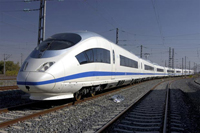The earliest recorded railways appeared in Greece during Antiquity and then in medieval Europe, operated by human or animal power. The Industrial Revolution changed the nature of railways with the invention of the steam engine, which paved the way for the development of the first electrified trains in the 1880s. Railways have since gone on to function as a major economic force around the world and an essential part of our national and international infrastructure.
Railway engineering is an engineering discipline that deals with the design, construction and operation of railway systems. Its roots are in the early nineteenth century when the need for specialised engineers capable of dealing with the unique problems of the new railway systems emerged.
Railway Engineers of Note
The most notable engineers in Great Britain to be involved in the field were Richard Trevithick, George Stephenson, and Isambard Kingdom Brunel.
Richard Trevithick (1771 – 1833) was responsible for the development of the first high-pressure steam engine and the first working steam locomotive. Safe production of high-pressure steam was not possible until Trevithick’s time when boiler technology had improved enough to minimise the risks. A double-acting cylinder was used, with steam distribution by means of a four-way valve. Trevithick’s locomotive was named ‘Puffing Devil’ and, in 1801, it was used in what is widely recognised as the first public demonstration of transportation powered by steam.
George Stephenson (1781 – 1848) was inspired by Trevithick and went on to design his first locomotive in 1814. He has since earned the title of ‘Father of the Railways’ for building the Liverpool and Manchester Railway which opened to the public in 1830. Previously, he had successfully built the eight-mile Hetton Colliery Railway and the twenty-five mile Stockton and Darlington Railway. The Liverpool and Manchester Railway ran for sixty miles and involved the construction of numerous difficult cuttings, embankments and stone viaducts to successfully level the route. Stephenson also had to contend with hostility from affected landowners and intense scrutiny by Parliament – something which has not changed to date as can be seen in some contemporary reactions to Crossrail and High Speed Rail!
It is also worth noting that the rail gauge, which refers to the spacing of rails on a railway track, developed by Stephenson of four feet eight and a half inches has become the standard for most of the world’s railways – hence its honorary title of the Stephenson gauge.
Isambard Kingdom Brunel (1806 – 1859) is considered to be a giant of the Industrial Revolution. In 1833, he was appointed as chief engineer of the Great Western Railway, which ran from London to Bristol and would be extended to Exeter at a later date. Brunel’s vision was for a passenger to be able to purchase a ticket in London that would take them all the way to New York – with the latter part of the journey being completed by steamship.
He took the controversial decision to use a broad gauge of seven feet because he had calculated it would allow for higher speed, stability and comfort for passengers, and allow for larger carriages and increased freight capacity. The route of the railway itself included soaring viaducts – granite piers from one of these still survive at Ivybridge – and the Box Tunnel, which was the longest railway tunnel in the world at that time. It is rumoured the Box Tunnel had been oriented so that the rising sun would shine through it on Brunel’s birthday every year. Following Brunel’s death, standard gauge was introduced for all railways across the country though examples of the original broad gauge rails still survive at the Great Western Railway’s original terminus of Neyland in Wales.
Brunel also contributed to railway engineering by designing stations at London Paddington, Mortimer, Charlbury and Bridgend, and Culham, which all survive in good condition to this day.
Crossrail, High Speed Rail, and the Future
Two hundred years after the advances of Trevithick, Stephenson, and Brunel, we are entering an exciting new era of railway engineering as a number of major projects promise to change the way we travel in Great Britain.
Crossrail is a seventy-three mile railway under construction in London, which is expected to be opened to the public in 2019. The aim of Crossrail is to provide a high-frequency service that will connect Berkshire and Buckinghamshire, via Central London, to Essex and South East London. Proposals for a project of this kind date back to the 1940s, with a total of five proposals having been turned down before Crossrail was approved in 2005, with preparation works commencing in 2009-10, including the demolition of notable buildings around key sites in Central London. As it did during the Industrial Revolution, railway engineering continues to shape and re-shape the world around us.
 High-speed rail is defined as railway lines with top speeds greater than 200 – 250 km/h (124 – 155 mph). The first purpose-built high-speed railway in the United Kingdom was the Channel Tunnel link, which was re-branded as High Speed One and provoked a significant discussion at all levels of public life regarding the value of constructing further high-speed lines. A second line dubbed High Speed Two has been planned to connect London with Birmingham and other cities in the north of England, and plans are underway for a Scottish high-speed railway that will be ready to open in 2024. Needless to say, the controversy has not abated in light of these new plans.
High-speed rail is defined as railway lines with top speeds greater than 200 – 250 km/h (124 – 155 mph). The first purpose-built high-speed railway in the United Kingdom was the Channel Tunnel link, which was re-branded as High Speed One and provoked a significant discussion at all levels of public life regarding the value of constructing further high-speed lines. A second line dubbed High Speed Two has been planned to connect London with Birmingham and other cities in the north of England, and plans are underway for a Scottish high-speed railway that will be ready to open in 2024. Needless to say, the controversy has not abated in light of these new plans.
Just as there was controversy in Brunel’s time over using different gauges to increase the speed and capacity of our railways, so the debate continues today in a different context as railways continue to be one of the major players in the future of our transport infrastructure.
Content with kind permission of the Institution of Civil Engineers (www.ice.org.uk)
